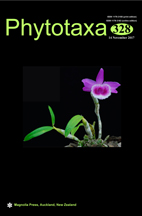Abstract
Crepidotus stenocystis and C. brunnescens are morphologically similar species defined by globose to subglobose spores, the presence of clamp connections in all tissues and bottle-like or flask-like cheilocystidia. They are also similar in the pileal aspect which is hygrophanous, glabrous or white-fibrillose, at first white but becoming brownish with age. Each are described from separate continents and have only been reported from their respective continents, C. stenocystis from Europe and C. brunnescens from North America. The phylogenetic analysis of ITS and LSU nrDNA regions from original type material confirms the existence of two distinct species, C. brunnescens that is more closely related to C. malachioides, and C. stenocystis that is more closely related to C. applanatus. Crepidotus stenocystis differs from C. brunnescens by its more prominent spore ornamentation and longer cheilocystidia that are frequently narrowly utriform. Based on the studied material and published data, it seems that C. stenocystis is distributed throughout all of Europe and does not occur in North America, whereas C. brunnescens is only known from Michigan in the USA.

